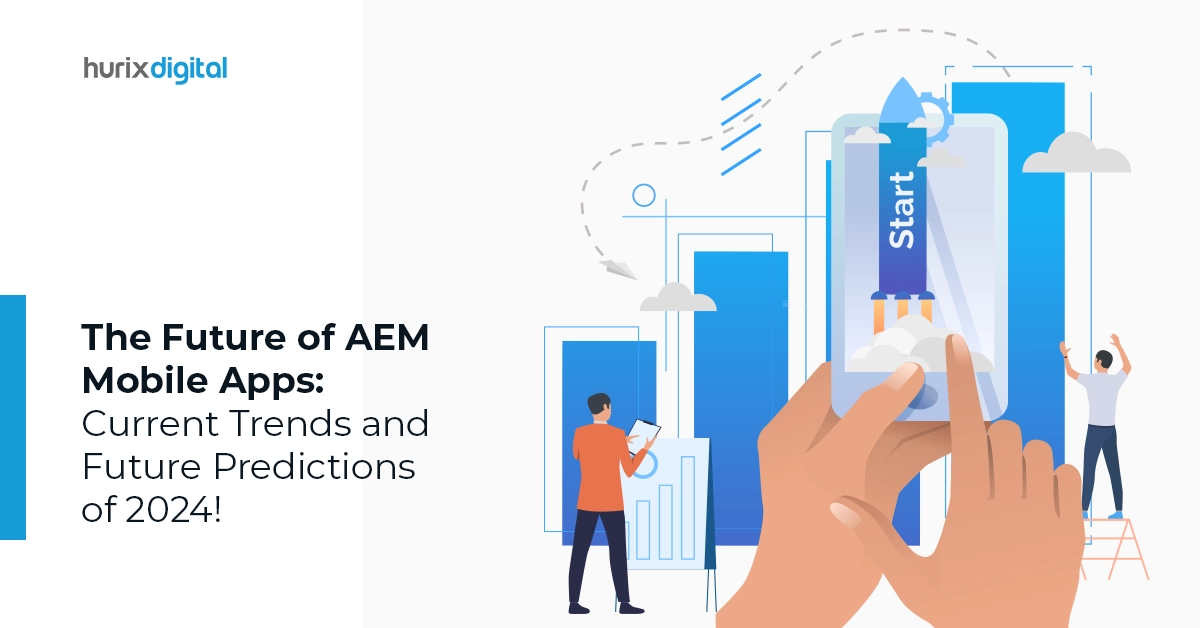The Future of AEM Mobile Apps: Current Trends and Future Predictions of 2024!
The online presence of businesses is of immense importance in today’s digital era. In such a competitive landscape, personalized content has the potential to make or break your brand.
Adobe Experience Manager (AEM) offers personalization tools for developers to craft individual experiences through their digital content. With the upcoming integration of augmented reality and virtual reality, developers can build a captivating world for consumers to immerse themselves in.
Moreover, once AI joins the party, one can expect smarter content management, automation, and AI-backed insights. As the global AI market is expected to reach 407 billion by 2027, there will be an increased demand for AEM developers fluent in AI.
Thus, AEM mobile apps promise a personalized, immersive, and AI-driven future.
Table of Contents:
- Adding AI and Machine Learning To The Mix
- Integrating AR and VR
- Enhanced Cloud Integration
- Development In Progressive Web Apps
- Headless Content Management Systems
- Making Data Privacy A Priority
- Mastering Advanced Tools to Personalize Customer-Centric Experiences
Top AEM Trends and Predictions in 2024
Let us look at the trends and predictions that will shape the future of AEM in 2024.
1. Adding AI and Machine Learning To The Mix
Regular greetings are a thing of the past, as 69% of customers prefer businesses that tailor content according to their shared information.
Realizing this phenomenon, Adobe Summit hinted at a future where AEM harnesses AI and machine learning to become advanced. It will offer features that predict users’ wants and recommend perfectly tailored content. It will also tag assets automatically.
AEM developers can benefit from upskilling in AI/ML integration within AEM. AI and ML integration aims at crafting an immersive experience that is automated and driven by the insights of AI. Thus, the future of AEM is brimming with opportunities for developers who embrace the AI wave.
2. Integrating AR and VR
The future holds the integration of augmented reality (AR) and virtual reality (VR) technologies into Adobe Experience Manager. Such an integration allows developers to showcase products through AR and immerse customers in virtual brand experiences, leveraging the full potential of such technologies.
As AR and VR gain traction, AEM is actively incorporating functionalities that support the creation and distribution of this immersive content. Developers who embrace this transformation and master the art of crafting and integrating AR/VR experiences will be at the forefront of shaping the future of brand interactions.
Also Read: How to Use Hybrid Apps to Improve Customer Engagement and Loyalty?
3. Enhanced Cloud Integration
Adobe’s initial offering of AEM as a Cloud Service paved the way for a scalable, flexible, and secure future. The forthcoming evolution promises an increased emphasis on cloud integration.
One can expect this integration, especially within the comprehensive cloud ecosystem of Adobe. Moving ahead in tune with this cloud-centric shift demands agility from developers.
Fluency in cloud architectures, deployments, and seamless integrations will become your most valuable asset. Seize the opportunity to lead the charge in crafting next-generation digital experiences by actively participating in the cloud revolution. AEM developers who master the cloud service domain are sure to hold the key to success.
4. Development of progressive Web Apps
The future of AEM might hold built-in support for Progressive Web Apps (PWAs). It will blur the lines between native apps and websites by offering an app-like experience in the browser without any downloads.
AEM developers must prepare to bridge the app gap by giving attention to PWA-centric design through this hybrid feature and leading the charge in crafting seamless user experiences.
5. Headless Content Management Systems
In response to the surging demand for seamless omnichannel experiences, headless Content Management Systems (CMS) have become increasingly popular.
Recognizing this trend, AEM is evolving towards a more flexible, API-first architecture. This shift signifies a departure from predetermined front-end structures to empower developers to retrieve content freely and tailor it to diverse channels and devices.
To fully leverage this functionality, developers must familiarize themselves with AEM’s headless capabilities and RESTful APIs to access and manipulate content elements and assemble them into cohesive experiences across various platforms. It fosters greater agility and adaptability in content delivery and ensures that brands can cater to their audiences effectively regardless of their preferred channel or device.
6. Making Data Privacy A Priority
AEM takes data privacy very seriously. AEM is set to focus increasingly on security to safeguard digital assets and user data. Developers must master secure coding practices and navigate the complexities of GDPR, CCPA, and other data protection regulations to build trust and protect valuable information.
7. Mastering Advanced Tools to Personalize Customer-Centric Experiences
AEM offers a revolutionary personalized experience with advanced tools that allow businesses to meticulously map intricate customer journeys and create unprecedented individualization. Developers who can master these tools will be able to craft an unforgettable and unique user experience.
AEM developers must prepare to delve deeply into this new paradigm and become the architects of personalized journeys that elicit genuine amazement from customers.
How Can Developers Gear Up for the AEM Future?
AEM is ready to undergo a revolutionary upgrade. In such a scenario, developers must familiarize themselves with the new ball game.
A good understanding of the use of AI and machine learning in AEM is important. They must deepen their cloud service expertise to navigate deployments and architectures seamlessly and master the flexibility of API-first development for omnichannel mastery. They must stay relevant with ongoing training and certifications in the evolving digital sphere, join AEM communities, attend conferences, and actively engage with peers to stay on top of trends and best practices.
Also Read: Top 6 Mobile App Development Frameworks for 2024!
To Sum Up
The stage is set for the next act of AEM, which is full of innovation to create experiences that captivate users. Developers have the opportunity to watch their careers and projects flourish by honing their skills.
Understanding these trends and equipping your teams with the right skillsets enable businesses to stay competitive and attract top talent who share your vision for AEM’s potential. Partner with Hurix Digital to upskill and innovate to optimize the AEM platform to create an experience that resonates with your audience.
Content is your digital weapon, and Hurix Digital enables you to craft ROI-dominating content that reigns supreme.

SVP & Head – Hurix Technology Solutions
Global Delivery head with 25 years of working experience in NYC investment banks and fintech companies. Hands-on technology delivery management and program management, accountable for stakeholder relationships, Strategic roadmap, P&L, Revenue growth, Account Management, and employee satisfaction.









